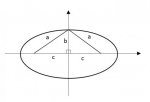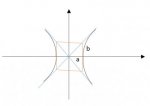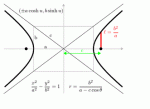Hello!
I would like to derive a formula for hyperbola but I struggle to think of a way to explain c in terms of b and a. Here is what I mean, I will use ellipse as an example first:
If we choose a point that lies exactly on the top minor vertex, then the sum of distances from focii has to be 2a, but the distances from focii to that point are equal, thus each line is a. Height of right angle triangle is b and distance from origin to focii is c. Thus we can express b^2 in terms of a^2 and c^2, which makes it possible to then derive the ellipse equation.
I however have an equation for a hyperbola in terms of a's and c's. I need later on to do a similar manipulation to derive a standard equation for hyperbola. I however cannot seem to be able to define the realtionship, whereas some sources define c^2 = a^2 + b^2 in hyperbola case. Here is the graph (poorly drawn) for hyperbola that I made:
What we have in particular case is a and height b, we can define that hypotenuse (portion of asymptote) as a^2 + b^2; but I cannot think why that portion length should be c, and that is what people claim it is(or at least what I think they claim it is). If I understand this, I could derive the hyperbola equation.
Thanks
I would like to derive a formula for hyperbola but I struggle to think of a way to explain c in terms of b and a. Here is what I mean, I will use ellipse as an example first:
If we choose a point that lies exactly on the top minor vertex, then the sum of distances from focii has to be 2a, but the distances from focii to that point are equal, thus each line is a. Height of right angle triangle is b and distance from origin to focii is c. Thus we can express b^2 in terms of a^2 and c^2, which makes it possible to then derive the ellipse equation.
I however have an equation for a hyperbola in terms of a's and c's. I need later on to do a similar manipulation to derive a standard equation for hyperbola. I however cannot seem to be able to define the realtionship, whereas some sources define c^2 = a^2 + b^2 in hyperbola case. Here is the graph (poorly drawn) for hyperbola that I made:
What we have in particular case is a and height b, we can define that hypotenuse (portion of asymptote) as a^2 + b^2; but I cannot think why that portion length should be c, and that is what people claim it is(or at least what I think they claim it is). If I understand this, I could derive the hyperbola equation.
Thanks



